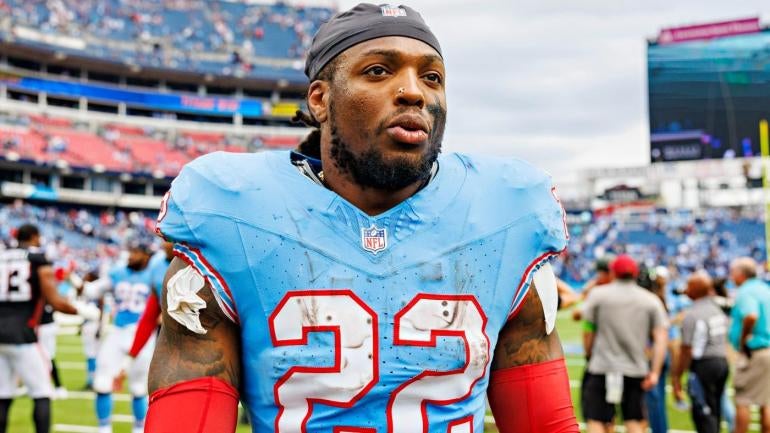Villanova’s Enoch Boakye rises up and puts down a monster jam vs. Colorado
The Villanova Wildcats' Enoch Boakye rose up and put down a monster jam vs. Colorado
 play_arrow
play_arrow
Radio Rehoboth


There was a flurry of activity as the trade deadline approached. Most notably, new owner Josh Harris put his stamp on the Commanders by revamping the defensive line, which was considered the strength of the team.
Edge rusher Montez Sweat, who is playing under an $11.5 million fifth-year option, was dealt to the Bears for a 2024 second-round pick. Young, Sweat’s counterpart at defensive end, was acquired by the 49ers for a 2024 compensatory third-round pick. The 2020 NFL Defensive Rookie of the Year is also in a contract year because the Commanders declined to pick up his $17.452 million fifth-year option during the offseason.
Here are three more trades that should have been made before the deadline that may have improved the chances of teams to make the postseason or go on a deep playoff run. The financial ramifications of the moves are highlighted. Salary cap space is based on NFLPA data.
Trades for big-name players such as Raiders wide receiver Davante Adams, Panthers edge rusher Brian Burns and Broncos cornerback Patrick Surtain II weren’t contemplated. There was no chance any of these three were going to be dealt before the deadline.
An acquiring team would have needed enough salary cap room to absorb the remainder of the player’s current salary. Since the trades would have occurred after Week 8’s games, the acquiring team would have been responsible for 10/18ths of a player’s 2023 base salary and any other applicable salary components in his contract.
Trades can’t be executed again until the 2024 league year begins on next March 13.
The Titans dealing two-time first-team All-Pro Bowl safety Kevin Byard to the Eagles for safety Terrell Edmunds, a 2024 fifth-round pick and a 2024 sixth-round pick last week suggested he wouldn’t be the only player leaving Tennessee via trade. 2023 second-round pick Will Levis having a good debut start in a 28-23 win over the Falcons on Sunday may have altered Tennessee’s thinking. Realistically, the Titans, who have a 3-4 record, will be fighting for a wild-card spot at best given the 6-2 Jaguars are clearly in control of the AFC South.
The Titans and Ravens reportedly had some discussions about a trade. The Ravens have a history of being aggressive at the trade deadline with acquisitions of edge rusher Yannick Ngakoue, cornerback Marcus Peters and linebacker Roquan Smith in recent years. Henry would have added a different dimension to the rushing attack for a team that has Super Bowl aspirations. The
last time the Ravens got past the divisional playoffs was during the 2012 season when they won Super Bowl XLVII.
It’s unlikely Henry fits into Tennessee’s plans beyond this season considering he has an expiring contract and will be 30 in January. The Titans used a third-round pick in this year’s NFL Draft on Tyjae Spears to seemingly be Henry’s replacement. Losing Henry would have left Spears as the lone running back on Tennessee’s 53-man roster. Edwards is a bigger running back (6-foot-1 and 238 pounds) in the mold of Henry although not nearly as talented. He also has an expiring contract.
The Ravens lack the cap space to take on Henry’s contract even with Edwards’ remaining salary coming off their books. Henry is making $10.5 million, all base salary, during the 2023 season. He also has a $500,000 incentive for 1,300 or more rushing yards that’s classified as likely to be earned because he had 1,538 yards on the ground last season.
By the Titans converting $4.5 million of Henry’s remaining $5,833,333 into a signing bonus to facilitate the trade, the Ravens would have only been responsible for $1,333,333 in salary plus the $500,000 cap charge for the rushing incentive. This could have been easily accommodated by the Ravens.
The Titans would have picked up $4,2311,111 of 2023 cap space from adding Edwards and dealing Henry thanks to losing his remaining base salary, the incentive, and the signing bonus being prorated through 2025 at $1.5 million annually because voiding 2024 and 2025 contract years were added during a 2022 contract restructure.
There was going to be $4,735,294 in 2024 dead money when Henry’s contract expired after the season because of the restructure. It would have increased to $7,735,294 with the additional $3 million in proration associated with 2024 and 2025 due to the salary conversion prior to the trade.

It would have been uncharacteristic for the Bengals to make a move at the trade deadline. An upgrade at tight end could have been justified because Irv Smith, Jr. isn’t having much of an impact. He hasn’t been an adequate replacement for Hayden Hurst, who turned his one-year stint in Cincinnati last season into a three-year, $21.75 million deal with the Panthers as a free agent.
The Patriots probably should have been sellers before the trading period ended. The 2-6 start to the season is the worst in Bill Belichick’s illustrious head coaching career since 2000 when he took over in New England.
Gesicki demonstrated he could be a reliable threat in the passing game with the Dolphins prior to Mike McDaniel’s arrival last season. The Patriots have some depth at tight end behind Hunter Henry in Pharaoh Brown.
The Raiders and Saints were close on a trade, according to NFL Media’s Ian Rapoport. The holdup was reportedly how much of Renfrow’s remaining 2023 salary the Raiders were going to eat in the deal. Given that Renfrow has been virtually non-existent this season and a likely salary cap casualty in the offseason, the Raiders should have been willing convert a significant portion of Renfrow’s money to signing bonus pre-trade. He has 10 catches for 92 yards in eight games this season.
Renfrow would have been reunited with quarterback Derek Carr in New Orleans. He was Carr’s favorite target in 2021 when he caught 103 passes for 1,038 yards with nine touchdowns. The Raiders rewarded Renfrow with a two-year, $31.7 million extension worth a maximum of $32 million in June 2022.
Renfrow’s remaining 2023 compensation consists of $3,611,111 in base salary and $333,000 of per game active roster bonuses. Since Renfrow was active for 10 games in 2022, only $74,000 of the $333,000 is currently a cap charge. With each successive game where Renfrow is active beyond last year’s number, $37,000 of 2023 cap space will be lost. There’s also the 2024 contract year worth $11.882 million.
Renfrow would have taken up $1,885,111 of the Saints’ 2023 cap space with the Raiders converting $1.8 million of Renfrow’s remaining base salary into signing bonus. The 2024 dead money would have increased by $1.35 million because the new signing bonus would be prorated at $450,000 annually due to there being voiding 2025 and 2026 contract years in Renfrow’s deal.
Adding $11.882 million in 2024 salary would be a deal breaker for practically any other team when there are already nearly $322 million in cap commitments for next year like the Saints have. Pushing as many cap obligations into the future as possible by restructuring contracts doesn’t faze the Saints. It’s standard operation procedure.
New Orleans has a legitimate shot at winning a weak NFC South. The Falcons and Saints are tied for first place with 4-4 records.
Go to Source
Author: Joel Corry
Written by: Joel Corry
The Villanova Wildcats' Enoch Boakye rose up and put down a monster jam vs. Colorado
Check out the best moments between the Oregon State Beavers and the UCF Knights in The Crown.


Copyright 2023 East Sussex Public Broadcasting, Inc.